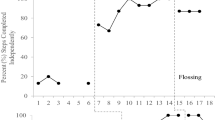Abstract
A color-coded “extra prompt” procedure was compared to a “no extra prompt” procedure in teaching autistic children and adolescents how to lace shoes. One randomly assigned group of 10 autistic subjects first learned to lace shoes whose laces and eyelets were color-coded red and white, and then encountered the no extra prompt condition in which color codes could no longer be depended upon to solve the position discriminations required to lace properly. In a counterbalanced fashion, the other group of 10 autistic subjects reached criterion on the non-color-coded, naturalistic shoe before experiencing the extra prompt condition. Analysis of variance and post-hoc analyses suggest that subjects who first learned under the color-coded, extra prompt condition encountered significant difficulty in transferring their newly acquired skill to the naturalistic, non-color-coded condition, whereas subjects who learned initially without the extra prompts had little difficulty with the subsequent color-coded condition. A follow-up procedure requiring all subjects to choose between the color prompt and the position cue revealed that 11 of 20 subjects consistently chose the color cue, even though it resulted in improper lacing. It is recommended that clinicians avoid the use of highly salient, non-criterion-related prompts in teaching certain types of adaptive skills to autistic children.
Similar content being viewed by others
References
Copeland, M., Ford, L., & Solon, N.Occupational therapy for mentally retarded children. Baltimore: University Park Press, 1976.
Doll, E. A.Vineland Social Maturity Scale. Circle Pines, Minnesota: American Guidance Services, 1965.
Etzel, B. C., & LeBlanc, J. M. The simplest treatment alternative: The law of parsimony applied to choosing appropriate instructional control and errorless-learning procedures for the difficult-to-teach child.Journal of Autism and Developmental Disorders, 1979,9, 361–382.
Horowitz, I. W. ADL training of the child with perceptual-motor dysfunction: The basic percepts approach.American Journal of Occupational Therapy, 1967,21, 10–17.
Koegel, R. L., & Rincover, A. Some detrimental effects of using extra stimuli to guide learning in normal and autistic children.Journal of Abnormal Child Psychology, 1976,4, 59–71.
Koegel, R. L., & Wilhelm, H. Selective responding to the components of multiple visual cues.Journal of Experimental Child Psychology, 1973,15, 442–453.
Litrownik, A. J., McInnis, E. T., Wetzel-Pritchard, A. M., & Filepelli, D. L. Restricted stimulus control and inferred attentional deficits in autistic and retarded children.Journal of Abnormal Psychology, 1978,87, 554–562.
Lovaas, O. I., Schreibman, L., Koegel, R., & Rehm, R. Selective responding by autistic children to multiple sensory input.Journal of Abnormal Psychology, 1971,77, 211–222.
Ornitz, E. M., & Ritvo, E. R. Medical assessment. In E. R. Ritvo (Ed.),Autism. New York: Appleton-Century-Crofts, 1976.
Prior, M. R. Cognitive abilities and disabilities in infantile autism: A review.Journal of Abnormal Child Psychology, 1979,7, 357–380.
Schopler, E., & Reichler, R. J.Individualized assessment and treatment for autistic and developmentally disabled children. Vol. 1. Psychoeducational profile. Baltimore: University Park Press, 1979.
Schover, L. R., & Newsom, C. D. Overselectivity, developmental level, and overtraining in autistic and normal children.Journal of Abnormal Child Psychology, 1976,4, 289–298.
Schreibman, L. Effects of within-stimulus prompting on discrimination learning in autistic children.Journal of Applied Behavior Analysis, 1975,8, 91–112.
Schreibman, L., & Lovaas, O. I. Overselective response to social stimuli by autistic children.Journal of Abnormal Child Psychology, 1973,1, 152–168.
Wilhelm, H., & Lovaas, O. I. Stimulus overselectivity: A common feature in autism and mental retardation.American Journal of Mental Deficiency, 1976,81, 26–31.
Author information
Authors and Affiliations
Additional information
This research was supported by Boston University, Grant GRS 591 SAR. The authors wish to express their appreciation to the officers of Queens Services for Autistic Children and the Queens Chapter of the National Society for Autistic Children.
Rights and permissions
About this article
Cite this article
Nelson, D.L., Gergenti, E. & Hollander, A.C. Extra prompts versus no extra prompts in self-care training of autistic children and adolescents. J Autism Dev Disord 10, 311–321 (1980). https://doi.org/10.1007/BF02408290
Issue Date:
DOI: https://doi.org/10.1007/BF02408290




